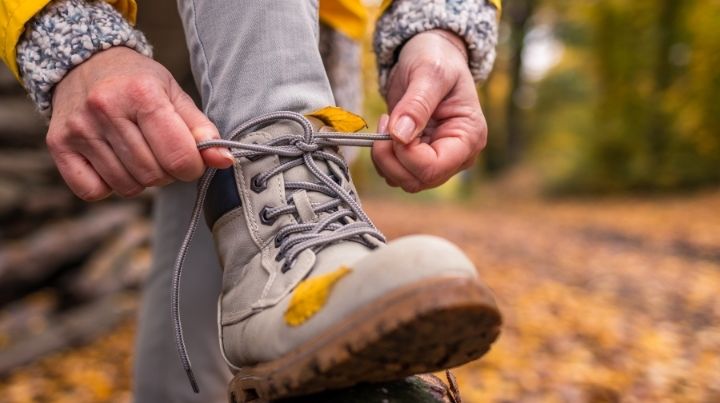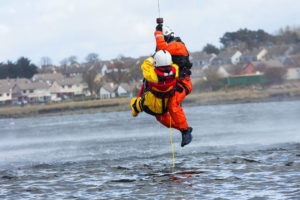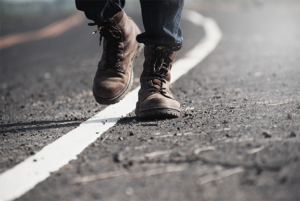Seven Benefits of Waterproof Footwear in an Emergency

By Chris Jones | KeepDryFeet.com
When you’re in a disaster situation, you’ve got a lot to think about. You’re assessing the situation, you’re reacting to it, and you’re grabbing the right gear. The last thing that you want to be putting a lot of thought into is whether or not you have waterproof footwear. You want to have the appropriate waterproof footwear close by so that you don’t even have to think twice when you go into response mode.
While there isn’t any one type of footwear that will serve the purpose of every kind of disaster response, there are some general guidelines to consider when prepping your footwear. Many disastrous situations involve water: flooding, tornadoes, hurricanes, severe thunderstorms, and snowstorms. That means having waterproof footwear is extremely important.
1. Waterproof Footwear Keeps Your Feet Warm and Dry
This is the most obvious reason to have waterproof footwear. Think about it – when you’re dealing with extreme conditions, you don’t want to waste your time  dealing with wet, cold, and uncomfortable feet.
dealing with wet, cold, and uncomfortable feet.
Also, depending on how long your feet stay wet, you could run the risk of certain health conditions like trench foot, which can cause feet to become cold, numb, swollen, painful, and discolored.
Trench foot doesn’t develop in just freezing temperatures. It’s caused by prolonged exposure to wet, cold conditions. It can take less than a day of exposure to damp conditions to cause it. Although trench foot is fully treatable, preventing it first by wearing waterproof footwear is a much better and more comfortable option.
2. Cleanliness and Hygiene
Floodwater is dirty. I mean, really dirty. And if you’re walking through significant amounts of floodwater, you’re running the risk of exposing yourself to all sorts of contaminants, like hazardous or toxic substances, pesticides, animal waste, raw sewage, chemicals, and high bacterial counts. According to the United States Environmental Protection Agency (EPA), exposure to contaminated floodwater is linked to health issues like intestinal problems, upset stomachs, headaches, and flu symptoms.
So, one of the best ways to minimize exposure to potentially contaminated floodwater is to wear waterproof footwear and avoid your skin touching the floodwater as much as possible.
3. Walking Through Debris
 Containments aren’t the only risks in floodwater. Depending on how deep it is, who knows what kind of debris and other hazards are hidden beneath the surface. Strong winds and surging floodwaters can cause all sorts of items to be uprooted and cause potential hazards, and even the seemingly smallest piece of garbage could cause an injury.
Containments aren’t the only risks in floodwater. Depending on how deep it is, who knows what kind of debris and other hazards are hidden beneath the surface. Strong winds and surging floodwaters can cause all sorts of items to be uprooted and cause potential hazards, and even the seemingly smallest piece of garbage could cause an injury.
The last thing you want to do is wear sandals or even sneakers when walking through potentially dangerous floodwater. Sturdy, waterproof footwear will provide much more protection from debris. You might even consider steel-toed safety boots, which provide an added degree of safety when walking through debris.
4. Slip Resistance and Traction
Even when you can see where you’re walking, water, snow, and ice can all cause slippery conditions for walking. And often, during a disastrous situation, you’re not paying attention to directly what’s in front of your feet – you’re busy reacting to all the commotion and activity around you.
You want to do as much as possible to avoid slipping and falling and injuring yourself during a disastrous situation. Waterproof footwear often has a rubber sole or strong grips to provide solid slip resistance, traction, and a more secure footing. All of this can help you stay upright when walking on slippery or uneven surfaces.
5. Waterproof Footwear Can Be Resistant to Chemicals and Solvents
Water isn’t the only liquid that you need to worry about during a disaster. Chemicals, fuels, or other solvents that are usually stored safely could be disrupted by floodwaters, extremely high winds, or debris caused by high winds.
I’m not saying that waterproof footwear will protect you from all the potential chemical spills that could occur. Still, many rubber boots do provide a high degree of resistance to chemicals and other solvents. You might want to consider having a pair of rubber boots in your emergency preparedness kit so that you can react appropriately when certain types of disasters strike.
6. Antistatic and Shock Protection
Downed power lines are often the result of many extreme weather conditions and can cause a serious threat. While you should never approach or touch a downed power line, you may find yourself needing to move around a downed power line in some disastrous situations.
Safety guidelines for moving around downed power lines include keeping your feet close together and shuffling away from the downed power line without picking up your feet. In addition to being waterproof, many safety types of rubber safety boots are antistatic, which means they will help avoid an electrostatic charge and minimize the risk of electric shocks.
7. Comfort
 Again, this might seem obvious. If you’re in the middle of a flood or other extreme water weather condition, having dry feet is going to make a huge difference while you’re responding to the disastrous situation.
Again, this might seem obvious. If you’re in the middle of a flood or other extreme water weather condition, having dry feet is going to make a huge difference while you’re responding to the disastrous situation.
Many types of waterproof footwear are shock absorbing and lightweight. This is extremely important, considering you might be on your feet for hours at a time. Don’t think of just rubber boots here. Many types of work or hiking boots can offer waterproof protection while also providing shock absorption and ankle support.
In addition to waterproof footwear, you will want to consider appropriate types of socks or liners to wear as well. Your feet don’t always get wet just from the water they’re exposed to on the outside. When you’re wearing the same pair of shoes for hours at a time, your feet are inevitably going to sweat and get wet. Wearing moisture-wicking socks, and changing them often, will help keep your feet dry inside your footwear.
Many footwear liners also add to your comfort by providing moisture-wicking properties and extra shock absorption.
The Bottom Line on Waterproof Footwear
There isn't one magic type of shoe or boot that will be appropriate for all emergencies. Just as each disaster is unique, so is the specific gear you’re going to require. The best response is to have several waterproof footwear options in your emergency kit so that you can respond appropriately when any disaster strikes.
What is your favorite waterproof footwear? Is there a specific brand or style you recommend? Have you tested a particular boot under extreme situations? Let's discuss it in the comments.
About the Author ~ Chris Jones:
With over 20 years in the construction industry and an avid outdoors enthusiast, Chris personally knows the importance of protecting your feet from the elements. His site, keepdryfeet.com, is a one-stop blog for everything you’ll ever need to know about how to keep your feet warm and dry for whatever outdoor situation you’re in.
Related Articles
FREE Guide
Read the Best Seller
Join Mind4Survival
Stay informed by joining the Mind4Survival! 100% Secure! 0% Spam!
Affiliate Disclosure...
Mind4Survival is a free, reader-supported information resource. If you make a purchase through our link, we may, at no cost to you, receive an affiliate commission.
Do You Want To Be Ready No Matter What?

Download our free 39-page guide with interactive, 7-Day Emergency Kit Checklist and take the first step toward real preparedness.
- Know exactly where to start.
- Save time and money.
- How-to build a complete Basic Emergency Kit.
- Level up your safety and security.
Join Mind4Survival
Stay informed by joining the Mind4Survival! 100% Secure! 0% Spam!






Thanks for the tips on how to keep the feet dry when Mother Nature calls.
We will be sure to share your post with our readers, well done.